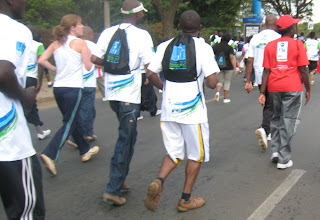
(A Kenyan doctor friend Mike comes up to Rachel and says congratulations, with a gesture towards the baby bump.)
Wait a second, Mike. I had heard that Kenyans never acknowledge a pregnancy until the baby comes.
That's totally true. You can't mention it, even when she is almost ready to deliver. But you're a Westerner, and everyone knows that you guys don't mind, so we can say it to you.
Well, what if we went out to a rural village, and saw a very pregnant lady, and said, "Congratulations, mama! When is your baby due?"
Oh, that would be fine, because even in the remote areas, they know that Westerners are different on this. But, if I were with you and said the same thing, they would be very offended.
But there's an indirect way that you can ask, right? You can say, "When will you be inviting us over for tea, or lunch (implied: to see the new baby)?"
Absolutely, that is what you would say. But you can't mention it or even prepare much for it. But younger generations of Kenyans are now having baby showers and things like that. But even them, even at a baby shower, you can't verbally mention it. It's still taboo.
Wait. You're at a baby shower for a pregnant lady, but you can't acknowledge she's pregnant? Then what do you say when you give her a gift of a crib or some baby clothes?
Oh, you just say, "Here, these are for you. I thought maybe you would like them. Just put them away somewhere, and maybe you fill find them useful one day."
So, Mike, I gotta tell you that as an American, I find this pretty strange. Do Kenyans find it equally strange that Westerners would ask freely about a pregnancy?
Oh, of course, they would be like, "Eh, why are you talking about a baby that isn't even born yet?"
--The sobering part of this awesome conversation is that we were in agreement that the likely source of this cultural difference springs from the vastly differing neonatal mortality rates, and the reluctance to expect too much in a society that loses so many babies. Nevertheless, we remain grateful to friends like Dr. Mike to help us navigate the cultural waters.






.jpg)










































